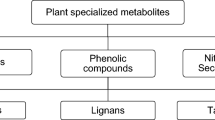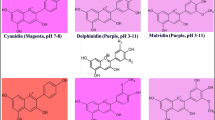Abstract
Vitis vinifera cv. Koshu is a traditional grape cultivar that has been grown for centuries in Japan. The Koshu grape has pink-colored skin and Koshu wines have slight astringency. We demonstrated for the first time the characterization of hydroxycinnamic acids, flavan-3-ols, and flavonoids in Koshu grape using high-performance liquid chromatography and liquid chromatography–mass spectrometry. The gross weight of phenolic compounds excluding anthocyanins and proanthocyanidins in Koshu grape at harvest was higher than those in Sauvignon Blanc, Chardonnay, and Merlot grapes. In addition, hydroxycinnamic acid and monomeric flavonol contents in Koshu grape were also higher than those in the other grape cultivars. Transcription analysis of cinnamic acid 4-hydroxylase, p-coumarate 3-hydroxylase, caffeate methyltransferase, and flavonol synthase genes indicated high accumulation of hydroxycinnamic acids and flavonols in Koshu grape skin compared with the other cultivars. These findings obtained by chemical and molecular approaches partially explained the phenolic characteristics and the peculiar astringency of Koshu grape.





Similar content being viewed by others
References
Ari’Izumi K, Suzuki Y, Kato I, Yagi Y, Otsuka K, Sato M (1994) Winemaking from Koshu variety by the sur lie method: change in the content of nitrogen compounds. Am J Enol Vitic 45:312–318
Baranac JM, Petranovic NA, Dimitric-Markovic JM (1997) Spectrophotometric study of anthocyan copigmentation reactions. 2. Malvin and the nonglycosidized flavone quercetin. J Agric Food Chem 45:1694–1697
Baranowski JD, Nagel CW (1981) Isolation and identification of the hydrocinnamic acid derivatives in white Riesling wine. Am J Enol Vitic 32:5–13
Castellarin SD, Gaspero DG (2007) Transcriptional control of anthocyanin biosynthetic genes in extreme phenotypes for berry pigmentation of naturally occurring grapevines. BMC Plant Biol 7:46
Chatonnet P, Dubourdieu D, Noel J, Lavigne V (1993) Synthesis of volatile phenols by Saccharomyces cerevisiae in wines. J Sci Food Agric 62:191–202
Cheynier V, Rigaud J (1986) HPLC separation and characterization of flavonols in the skin of Vitis vinifera var. Cinsault. Am J Enol Vitic 37:248–252
Dashek WV (ed) (1997) Methods in plant biochemistry and molecular biology. CRC, Boca Raton, pp 177–188
Downey MO, Harvey JS, Robinson SP (2003) Synthesis of flavonols and expression of flavonol synthase genes in the developing grape berries of Shiraz and Chardonnay (Vitis vinifera L.). Aust J Grape Wine Res 9:110–121
Downey MO, Harvey JS, Robinson SP (2004) The effect of bunch shading on berry development and flavonoid accumulation in Shiraz grapes. Aust J Grape Wine Res 10:55–73
Fujita A (2008) Accumulation and biosynthetic gene expression of flavonols and flavan-3-ols in grape berries (thesis). Yokohama National University, Yokohama
Fujita A, Goto-Yamamoto N, Aramaki I, Hashizume K (2006) Organ-specific transcription of putative flavonol synthase genes of grapevine and effects of plant hormones and shading on flavonol biosynthesis in grape berry skins. Biosci Biotechnol Biochem 70:632–638
Fulcrand H, Remy S, Souquet JM, Cheynier V, Moutounet M (1999) Study of wine tannin oligomers by on-line liquid chromatography electrospray ionization mass spectrometry. J Agric Food Chem 47:1023–1028
Goto-Yamamoto N (2000) Phenetic clustering of grapes (Vitis spp.) by AFLP analysis. Breed Sci 50:53–57
Iino S, Hikawa Y, Nakayama T, Ogino S (2004) Control of flavor components in white wines using grape “Koshu” by various wine-making methods (3rd report). Rep Yamanashi Industrial Technol 18:138–140
Jeong ST, Goto-Yamamoto N, Hashizume K, Esaka M (2008) Expression of the multi-copy flavonoid pathway genes coincides with anthocyanin, flavonol and flavan-3-ol accumulation of grapevine. Vitis 47:135–140
Kennedy JA, Matthews MA, Watherhouse L (2002) Effect of maturity and vine water status on grape skin and wine flavonoids. Am J Enol Vitic 53:268–274
Kobayashi H, Tominaga T, Ueno N, Ajimura K, Aruga Y, Dubourdieu D, Okubo T (2004) Key odorous compounds in Koshu wine. J ASEV Jpn 15:109–110
Kobayashi H, Tominaga T, Katsuno Y, Anzo M, Ajimura K, Suzuki Y, Dubourdieu D, Okubo T (2006) Influence of volatile phenol concentration in Koshu wine quality. J ASEV Jpn 17:75–80
Kobayashi H, Tominaga T, Katsuno Y, Anzo M, Ajimura K, Saito H, Suzuki Y, Dubourdieu D, Konno K (2007) Effect of improvement factor for β-damascenone content in Koshu wine and application to wine making. J ASEV Jpn 18:22–27
Kobayashi H, Suzuki S, Tanzawa F, Takayanagi T (2009a) Low expression of flavonoid 3′,5′-hydroxylase (F3′, 5′H) associated with cyanidin-based anthocyanins in grape leaf. Am J Enol Vitic 60:362–367
Kobayashi H, Fujita K, Suzuki S, Takayanagi T (2009b) Molecular characterization of Japanese indigenous grape cultivar “Koshu” (Vitis vinifera) leaf and berry skin during grape development. Plant Biotechnol Rep 3:225–241
Kobayashi H, Takase H, Kaneko K, Tanzawa F, Takata R, Suzuki S, Konno T (2010) Analysis of S-3-(hexan-1-ol)-glutathione and S-3-(hexan-1-ol)-l-cysteine in Vitis vinifera L cv. Koshu for aromatic wines. Am J Enol Vitic 61:176–185
Koyama K, Goto-Yamamoto N, Hashizume K (2007) Influence of maceration temperature in red wine vinification on extraction of phenolics from berry skins and seeds of grape (Vitis vinifera). Biosci Biotechnol Biochem 71:958–965
Matus JT, Loyola R, Vega A, Pena-Neira A, Bordeu E, Arce-Johnson P, Alcalde JA (2009) Post-veraison sunlight exposure induces MYB-mediated transcriptional regulation of anthocyanin and flavonol synthesis in berry skins of Vitis vinifera. J Exp Bot 60:853–867
Okamura S, Watanabe M (1981) Determination of phenolic cinnamates in white wine and their effect on wine quality. Agric Biol Chem 45:2063–2070
Price SF, Breen PJ, Valladao M, Watson T (1995) Cluster sun exposure and quercetin in Pinot noir grapes and wine. Am J Enol Vitic 46:187–194
Ribéreau-Gayon P, Stonestreet E (1968) Le dosage des anthocyanes dans le vin rouge. Bull Soc Chim Fr 47:2649–2652
Singleton VL, Rossi JA Jr (1965) Colorimetry of total phenolics with phosphomolybdic–phosphotungstic acid reagents. Am J Enol Vitic 16:144–158
Sun B, Ricardo-da-Silva JM, Spranger I (1998) Critical factors of vanillin assay for catechins and proanthocyanidins. J Agric Food Chem 46:4267–4274
Tesniere C, Vayda ME (1991) Method for the isolation of high-quality RNA from grape berry tissues without contaminating tannins or carbohydrates. Plant Mol Biol Rep 9:242–251
Tominaga T, Furrer A, Henry R, Dubourdieu D (1998) Identification of new volatile thiols in the aroma of Vitis vinifera L var. Sauvignon blanc wines. Flavour Fragr J 13:159–162
Yokotsuka K (1990) Effect of press design and pressing pressures on grape juice components. J Ferm Bioeng 70:15–21
Yokotsuka K (1995) Wine quality and phenolic compounds. Nippon Shokuhin Kagaku Kogaku Kaishi 42:288–297
Yokotsuka K, Matsunaga M, Singleton VL (1994) Comparison of composition of Koshu white wines fermented in oak barrels and plastic tanks. Am J Enol Vitic 45:11–16
Yokotsuka K, Ueno N, Singleton VL (2005) Removal of red blush and bitterness from white wine by partial hyperoxidation of juice from the pink-skinned Koshu variety. J Wine Res 16:233–248
Author information
Authors and Affiliations
Corresponding author
Rights and permissions
About this article
Cite this article
Kobayashi, H., Suzuki, Y., Ajimura, K. et al. Characterization of phenolic compounds biosynthesized in pink-colored skin of Japanese indigenous Vitis vinifera cv. Koshu grape. Plant Biotechnol Rep 5, 79–88 (2011). https://doi.org/10.1007/s11816-010-0162-z
Received:
Accepted:
Published:
Issue Date:
DOI: https://doi.org/10.1007/s11816-010-0162-z




